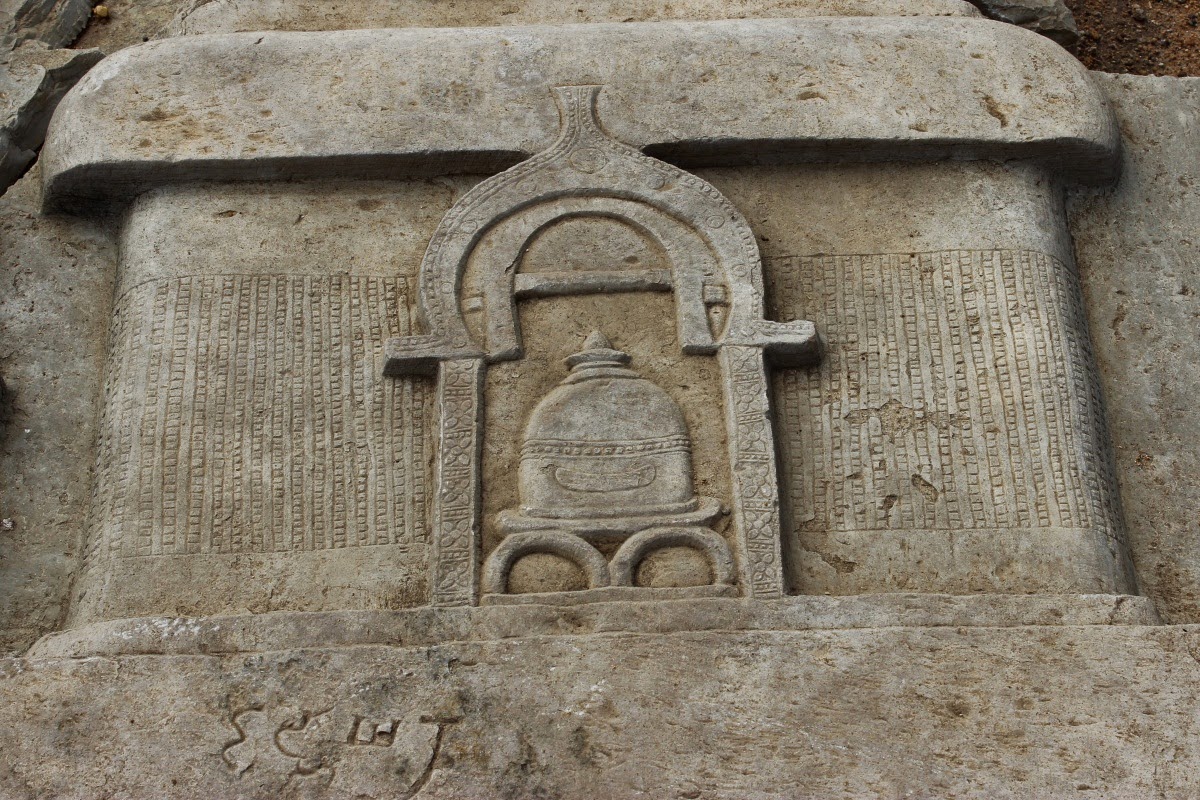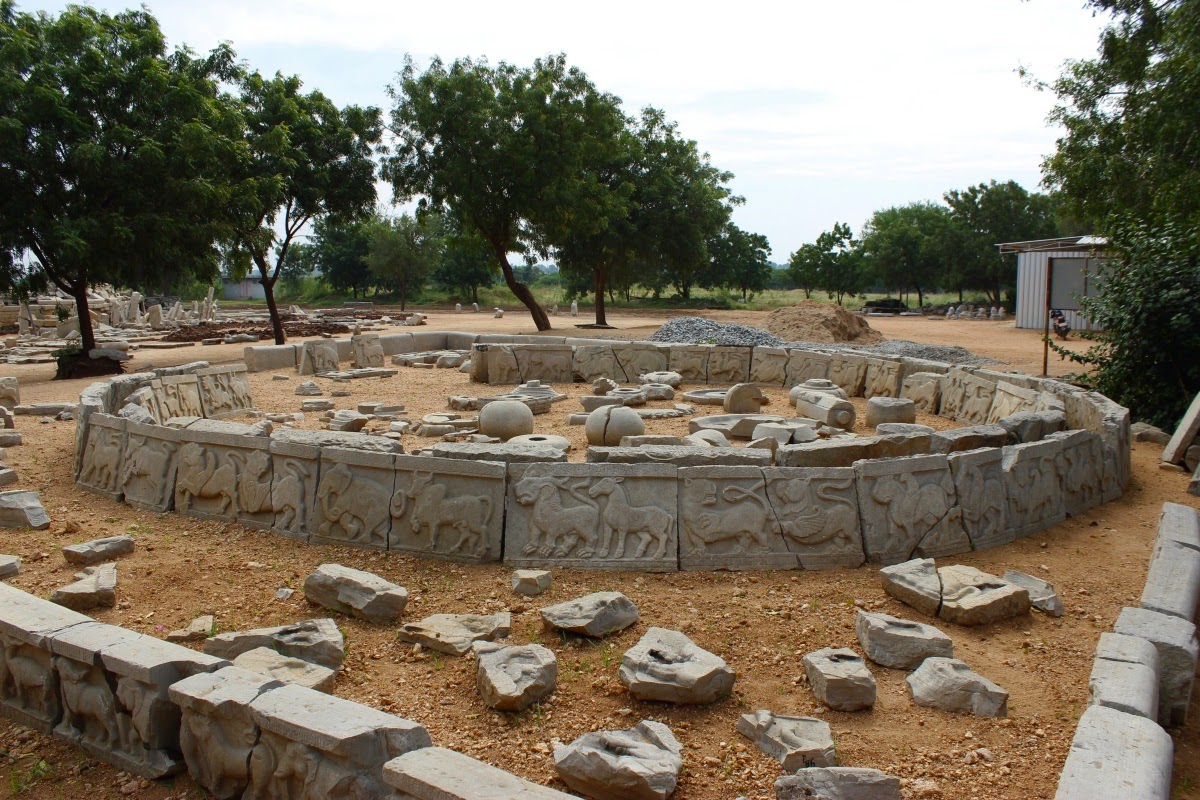..continuing from Ruins of a stupa, Kanaganahalli-Sannati. This post is a collection of sculptures depicting life of Gautama Buddha and symbols of Buddhism. These pictures are not arranged in any particular order but each of them have a story in it.
November 28, 2014
This is a stupa with a egg shaped object in it. The two women on the outside seem to be fanning the egg shaped object. Flanking the stupa are richly decorated pillars. The tree here might be the Bodhi tree under which Buddha attained enlightenment.
A nine headed serpent forming five loops. The number nine is considered important in Hinduism, perhaps in Buddhism too. You can see multi-headed serpents in Jain images too.
A five headed serpent. Note the detailed work of its scales. The heads are unusual here, not like the ones seen earlier. On the right is a voluptuous woman, her hair in five plaits. Note the imaginary creature.. half elephant-half fish.
A stupa and a signature. No clue what the columns of squares represent, each columns has 30+ indentations.
Wheel with 32 spokes - this should be a Dharmachakra, one of the oldest known Buddhist symbols. Quoting a line from Wikipedia: "The Buddha is said to have set the "wheel of dhamma" (Dharmachakra) in motion when he delivered his first sermon."
This seems to be a meeting of princes with a monkey. Two princes seem to be wearing pearl necklaces. The prince with a cushion under his feet could be a king and monkey is paying obeisance. The pillar on the right is decorated with three lotuses.
Four young women. The two woman with coils around their lower legs could be princesses while the other two are their attendants. These women are wearing lot of jewelry like pearl necklaces, bangles, waist bands and headgear.
This looks like a dream.. men, women, animals, birds, buildings, chariots and imaginary creatures.
Two princes and three midgets. The princes are attired in loin clothes, pearl necklaces and cloth headgear. They seem to be carrying some weapons in their hands.
A Stupa flanked by equally high columns. One column has a Dharmachakra while the other one has a lion. No idea what the mushroom like objects coming out of the Stupa. At the base is a man with hair tied in a bun over the head - this might be Buddha himself.
The Stupa image is part of the outer wall of Sannati Stupa. In the foreground is a pillar with a lotus and another wheel which might be a Dharmachakra in different form. On the right is a large temple with niches in its tapering Shikhara. The temple is flanked by two trees and in the foreground is an ox-cart, its oxen are relaxing, one is being fed by a man while the other is sleeping.
Another temple with eight niches in its Shikhara. The temple has seven pillars in its elevation. A stairway is seen behind the columns. This is a multi-storeyed building with access to terrace.
Seems like four princes are offering a heavy piece of garment to a princess. The princes headgears are different. At the top are ducks taking flight.
This is a depiction of railing around a stupa. On the pillars are lotuses and other flowers. At the bottom are two inscriptions.. probably signatures of people who created it.
Armed warriors charging into a battle. The warrior on foot is wielding a sword and a shiled. The warrior on horseback is an archer. Notice the lotus icon on the horse's neck.
Warriors on a charging elephant. One is a mahout, two are archers and the remaining two are just watching the action.
This is either a multi-storeyed building or a hillock with several stairways leading to its summit. There are two tile-roof houses at the base. At the top are two stupas and a tree.
This seems like a scene from a royal garden where servants are waiting for a prince to arrive. Three birds seen here must be peacocks.
This seems like a damaged base of a pillar. Note the smooth curvature and the intricate drawing of lotuses connected by waves.
This is one of the best sculptures I saw here. The tall women dominates the scene.. she must be a princess or an young queen. The necklace hanging down from her neck down to her abdomen is simply beautiful. She's wearing heavy ear pendants and anklets. The two women accompanying her must be her servants. One seems to be holding a mirror while the other one is carrying a box like object.
Coming to the last picture.. we have the emperor Ashoka himself here. He seems to be accompanied by his queen. A lady attendant is holding an umbrella over his head. two other attendants are fanning the royal couple. This is a rare sculpture of Empror Ashoka.
The sculpture is rare because of the presence of the emperor's name on it. At the top is an inscription which is supposed to read "Raja Asoka."
There were many more sculptures. Perhaps I will create another post some other time.
..........
November 28, 2014
This is a stupa with a egg shaped object in it. The two women on the outside seem to be fanning the egg shaped object. Flanking the stupa are richly decorated pillars. The tree here might be the Bodhi tree under which Buddha attained enlightenment.
A nine headed serpent forming five loops. The number nine is considered important in Hinduism, perhaps in Buddhism too. You can see multi-headed serpents in Jain images too.
A five headed serpent. Note the detailed work of its scales. The heads are unusual here, not like the ones seen earlier. On the right is a voluptuous woman, her hair in five plaits. Note the imaginary creature.. half elephant-half fish.
A stupa and a signature. No clue what the columns of squares represent, each columns has 30+ indentations.
Wheel with 32 spokes - this should be a Dharmachakra, one of the oldest known Buddhist symbols. Quoting a line from Wikipedia: "The Buddha is said to have set the "wheel of dhamma" (Dharmachakra) in motion when he delivered his first sermon."
This seems to be a meeting of princes with a monkey. Two princes seem to be wearing pearl necklaces. The prince with a cushion under his feet could be a king and monkey is paying obeisance. The pillar on the right is decorated with three lotuses.
Four young women. The two woman with coils around their lower legs could be princesses while the other two are their attendants. These women are wearing lot of jewelry like pearl necklaces, bangles, waist bands and headgear.
This looks like a dream.. men, women, animals, birds, buildings, chariots and imaginary creatures.
Two princes and three midgets. The princes are attired in loin clothes, pearl necklaces and cloth headgear. They seem to be carrying some weapons in their hands.
A Stupa flanked by equally high columns. One column has a Dharmachakra while the other one has a lion. No idea what the mushroom like objects coming out of the Stupa. At the base is a man with hair tied in a bun over the head - this might be Buddha himself.
The Stupa image is part of the outer wall of Sannati Stupa. In the foreground is a pillar with a lotus and another wheel which might be a Dharmachakra in different form. On the right is a large temple with niches in its tapering Shikhara. The temple is flanked by two trees and in the foreground is an ox-cart, its oxen are relaxing, one is being fed by a man while the other is sleeping.
Another temple with eight niches in its Shikhara. The temple has seven pillars in its elevation. A stairway is seen behind the columns. This is a multi-storeyed building with access to terrace.
Seems like four princes are offering a heavy piece of garment to a princess. The princes headgears are different. At the top are ducks taking flight.
Warriors on a charging elephant. One is a mahout, two are archers and the remaining two are just watching the action.
This seems like a scene from a royal garden where servants are waiting for a prince to arrive. Three birds seen here must be peacocks.
This seems like a damaged base of a pillar. Note the smooth curvature and the intricate drawing of lotuses connected by waves.
Coming to the last picture.. we have the emperor Ashoka himself here. He seems to be accompanied by his queen. A lady attendant is holding an umbrella over his head. two other attendants are fanning the royal couple. This is a rare sculpture of Empror Ashoka.
The sculpture is rare because of the presence of the emperor's name on it. At the top is an inscription which is supposed to read "Raja Asoka."
There were many more sculptures. Perhaps I will create another post some other time.
..........





























































